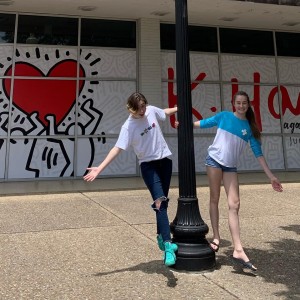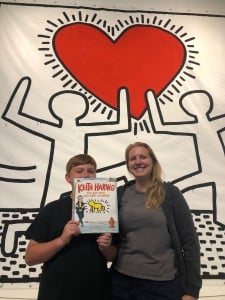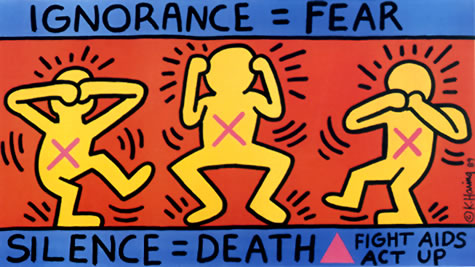Keith Haring Takes Over The Arlington Museum Of Museum Of Art
ArtandSeek.net August 1, 2019 49The pop artist Keith Haring died in 1990, but in a lot of ways, he’s still alive today.
His colorful and cartoonish artwork is everywhere – plastered on t-shirts, skateboards, even underwear. In this week’s Art&Seek Spotlight, Haring takes over the Arlington Museum of Art. And Art&Seek reports an odd set of circumstances spurred the artist’s invasion.

A photo of the Arlington Museum of Art’s signature work for the “Keith Haring: Against All Odds” exhibition. The work is untitled, but is often referred to as “Big Love.”
Photo: courtesy Arlington Museum of Art
Simple and energetic. That’s the easiest way to describe Keith Haring’s artwork. The second-easiest might be to compare his work to cave paintings. Either way, today his bold-outline drawings of dancing people and barking dogs are as recognizable as Warhol’s Soup Cans.
“He just uses a media that’s light enough to get people’s attention. And that kind of sticks with you,” says 15-year-old Camron DeLay. “But I do think when you think of Keith Haring it’s like all the fun colors and the shapes and symbols. It kind of makes you feel like, “(sigh) Oh! It’s Keith Haring.””
Art&Seek ran into DeLay and her family at the Haring exhibition in Arlington. She’s sporting a t-shirt with a Haring design as we talked. And she told us that this show’s her favorite of the summer.
“I mean, definitely! (laughs) It has to be, because I love all of his work,” she says. “No matter what I see, this is definitely going to stick with me.”
The exhibition – which is open until September – is called “Against All Odds.” And that’s sort of a perfect title because hosting an exhibition with an artist whose profile is as large as Haring’s is normally reserved for venues like The Modern in Fort Worth or the Dallas Museum of Art.
“It is a big deal,” says Chris Hightower, He curates the Museum’s exhibitions. He’s also president of the museum’s board. “We’ve had the largest opening week, the largest opening month, I mean, everything that we’ve done, we’ve done at the largest scale we’ve ever had.”

A screenshot of the message Jenifer Silverton sent to Chris Hightower at the AMA. Photo: Courtesy Jenifer Silverton
Beyond the show’s success, Hightower says its origin story is also unlike anything he’s experienced in his career. It all started with a sixth-grader and his mom. “One of our patrons and her son had read this book on Keith Haring,” he explains. “And so, the boy wanted to know if we could bring that exhibit to the Arlington Museum of Art.”
“It was actually just a random thing,” says Jenifer Silverton. “I really did not know about Keith Haring until I read the book. And then I recognized his artwork from when I was growing up, and then I kind of put the two and two together.”
“So they thought, ‘What the heck?” I guess.” explains Hightower. “And they just messaged me on Facebook. (laughs)”
The book Silverton and her son Sage read is called “Keith Haring: The Boy Who Just Kept Drawing.”
“I just liked Keith’s response to everything,” says Sage Silverton.
Sage explains the book’s about Haring’s rise to fame. And his favorite things about the book were Haring’s artwork and learning about the artist’s contempt for the establishment.
“People just asked him questions like, ‘Why do you do this stuff?’ And he just like looked back around and just kept on drawing anyway” he says.
That attitude meant Haring wasn’t always the art world’s darling.
“I started drawing in the subway in New York in 1980,” Haring told documentarians from Chicago’s WTTW in 1989. “Mostly, really, out of a desire to reach directly an audience or a public that was out there without going through the galleries or the museum situation.”
Haring explained to WTTW that his subway graffiti was part of a dialogue he was having with the city. And the endeavor catapulted his career. After five years, he brought his art above ground.
“There was a lot of pushback about his work,” says Hightower, “because he kind of came from the streets and was street art, but his art, I think, really appeals to a wide audience because it’s easy to access. So young people can catch on to it, but then his more challenging issues will push an older, more mature audience.”
Before Haring died of AIDS-related illnesses, he made serious, even frightening works that dealt with oppression, capitalism and of course the AIDS epidemic. Hightower says those works are why HELP – a North Texas health organization for the LGBTQ community – decided to sponsor the exhibition.
“I think they really loved it. Because it’s an AIDS service organization, and it was great that a young person wanted to know more about this artist and the artist’s work. I mean, everything just aligned beautifully,” Hightower says.
One of Haring’s goals as an artist was to democratize art. He wanted all people to have access to his work and his message. And today, in Arlington, that goal has been accomplished.














